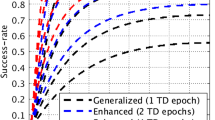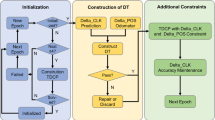Abstract
We introduce a simple single-band receiver clock jump and cycle slip (CJCS) detection and correction algorithm suitable for a standalone single-frequency Global Navigation Satellite System (GNSS) receiver. The real-time algorithm involves using an adaptive time differencing technique for the generation of adaptive difference sequences of single-frequency code and phase observations. The sequences are used for determining thresholds and for the detection and determination of a receiver clock jump and cycle slips. The cycle slip values are fixed by rounding-up float values obtained via weighted least squares adjustment, following the elimination of the receiver’s high-order clock drift at every epoch. The performance of this new technique was investigated with simulated cycle slip values and with different types of receiver clock jumps at millisecond and microsecond levels. It achieved 100% detection and correction of all types of receiver clock jumps; between 97 and 100% cycle slip detection; and between 96.9 and 100% cycle slip correction including cycle slips of ± 1 cycle, for different rates of observations acquired by different fixed and mobile GNSS receivers. The algorithm thus facilitates precise timing and positioning on standalone low-cost single-frequency GNSS devices.




Similar content being viewed by others
References
Cosser E, Hill JC, Roberts WG, Meng X, Moore T, Dodson HA (2004) Bridge monitoring with Garmin handheld receivers. In: 1st FIG international symposium on engineering surveys for construction works and structural engineering, Nottingham, UK, June 28–July 1
de Lacey MC, Reguzzoni M, Sanso F (2011) Real-time cycle slip detection in triple frequency GNSS. GPS Solut 16(3):353–362. https://doi.org/10.1007/s10291-011-0237-5
Deo M, El-Mowafy A (2015) Cycle slip and clock jump repair with multi-frequency multi-constellation GNSS data for precise point positioning. In: Proceedings of the International Global Navigation Satellite Systems Society (IGNSS) symposium 2015, Outrigger Gold Coast, Australia, July 14–16, pp 1–15
Fath-Allah FT (2010) A new approach for cycle slips repairing using GPS single frequency data. World Appl Sci J 3(8):315–325
Guo F, Zhang X (2014) Real-time clock jump compensation for precise point positioning. GPS Solut 18(1):41–50. https://doi.org/10.1007/s10291-012-0307-3
Jia P, Wu L (2001) An algorithm for detecting and estimating cycle slips in single-frequency GPS. Chin Astron Astrophys 25:515–521. https://doi.org/10.1016/S0275-1062(01)00105-9
Kim D, Langley BR (2002) Instantaneous real-time cycle-slip correction for quality control of GPS carrier-phase measurements. Navigation 49(4):205–222. https://doi.org/10.1002/j.2161-4296.2002.tb00269.x
Markovsky I, Huffel SV (2007) Overview of total least-squares methods. Signal Process 87(10):2283–2302. https://doi.org/10.1016/j.sigpro.2007.04.004
Momoh JA (2013) Robust GNSS point positioning in the presence of cycle slips and observation gaps. Ph.D. Dissertation, University College London, UK
Momoh JA, Ziebart M (2012) Instantaneous cycle slip detection, code multipath mitigation and improved ionospheric correction for enhanced GPS single-frequency. In: Proceedings of the ION GNSS 2012, Institute of Navigation, Nashville, Tennessee, USA, September 17–21, pp 1217–1232
Ren Z, Li L, Zhong J, Zhao M, Shen Y (2011) A real-time cycle-slip detection and repair method for single frequency GPS receiver. In: 2nd International conference on networking and information technology IPCSIT 2011, Hong Kong, pp 224–230
Weinbach U, Schon S (2011) GNSS receiver clock modeling when using high-precision oscillators and its impact on PPP. Adv Space Res 47(2):229–238. https://doi.org/10.1016/j.asr.2010.06.031
Author information
Authors and Affiliations
Corresponding author
Additional information
Publisher’s Note
Springer Nature remains neutral with regard to jurisdictional claims in published maps and institutional affiliations.
Rights and permissions
About this article
Cite this article
Momoh, J.A., Bhattarai, S. & Ziebart, M. Receiver clock jump and cycle slip correction algorithm for single-frequency GNSS receivers. GPS Solut 23, 38 (2019). https://doi.org/10.1007/s10291-019-0832-4
Received:
Accepted:
Published:
DOI: https://doi.org/10.1007/s10291-019-0832-4




